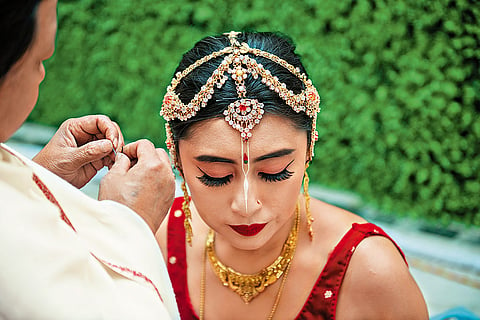
- Destinations
- Experiences
- Stay
- What's new
- Celebrating People
- Responsible Tourism
- CampaignsCampaigns
- Subscribe
- Buy Now

Luhongba, the main wedding ceremony in a Meitei marriage, is more than just the union of two people. The essence of the word, Luhongba, made by joining two words, "lu," meaning "head," and "hongba," meaning "to solemnise," lies in celebrating the union of two souls. For the bride, the day begins with her weaving two garlands—one for herself and the other for her groom. At noon, the groom makes his way to the bride's house in a ritual known as bor jatra.
At the bride's home, the ceremonies begin with the Sankirtana Pala, a Vaishnavite ritual. "Our wedding attire is the most unique in the world," said fashion designer Reena Ahanthem, who got married in a traditional Meitei ceremony in her hometown Imphal, Manipur, in 2019.
The potloi (a cylindrical skirt made of thick fabric and embellished with sequins) worn by the bride is created by potloi-setpis (potloi-makers) who have mastered the craft over generations. Ahanthem's potloi was made by Oja Laishram Sarat, a renowned potloi-maker.
"The Meitei wedding attire is incomplete without the gold ornaments passed down over generations. Brides wear rings with designs representing khoi-mahum (a bee hive) and pungton mapan (guava flower). Marei (a necklace symbolising marital happiness), and the two jhappas (traditional bridal headgear), for the forehead and the back of the head, are a must," said Ahanthem.
